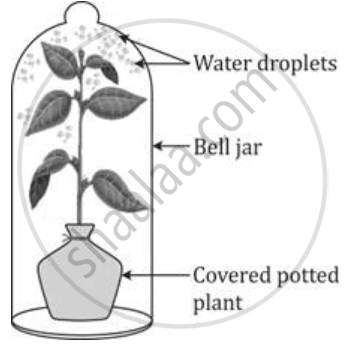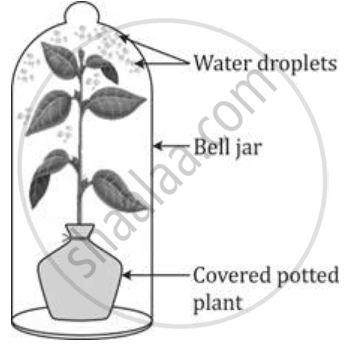Advertisements
Advertisements
प्रश्न
An apparatus, as shown below, was set up to investigate a physiological process in plants. The setup was kept in sunlight for two hours. Droplets of water were then seen inside the bell jar. Answer the questions that follow:

- Name the process being studied.
- Explain the process named above in Q.3(a)(i).
- Why was the pot covered with a plastic sheet?
- Suggest a suitable control for this experiment.
- Mention two ways in which this process is beneficial to plants.
- List three adaptations in plants to reduce the above mentioned process.
उत्तर
- Transpiration
- Transpiration is a process during which water is lost in the form of water vapour through the aerial parts of the plant.
- The pot is covered with a plastic sheet to prevent the evaporation of water from the soil.
- Place an empty, dry bell jar in the sunlight.
-
- It creates a cooling effect.
- It helps in the ascent of sap by creating a suction force.
- It helps in the distribution of water and mineral salts.
- Adaptations to reduce excessive transpiration:
- Leaves reduced in size or to spines
- Sunken stomata
- Leaves with thick cuticle
APPEARS IN
संबंधित प्रश्न
The loss of water in the form of water vapour through stomata on leaves is known as ___________.
Under what conditions do plant transpire more quickly?
Choose the correct answer:
More water loss in plants is the cause of wilting. This can be checked by ____________
An apparatus as shown below was set up to investigate a physiological process in plants. The setup was kept in sunlight for two hours. Droplets of water were then seen inside the bell jar. Answer the questions that follow:

Suggest a suitable control for this experiment.
An apparatus as shown below was set up to investigate a physiological process in plants. The setup was kept in sunlight for two hours. Droplets of water were then seen inside the bell jar. Answer the questions that follow:

Mention two ways in which this process is beneficial to plants.
What are stomata? What governs the opening and closing of stomata?
Why is transpiration called a necessary evil?
How can plants be grown under limited water supply without compromising on metabolic activities?
Plants show temporary and permanent wilting. Differentiate between the two. Do any of them indicate the water status of the soil?
